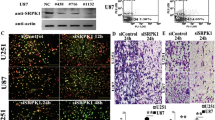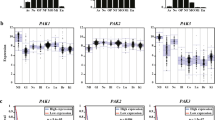Abstract
Gliomas remain to be an unresolved medical problem. Better understanding of complex regulation and key molecules involved in glioma pathology are needed for designing new and effective treatment modalities. Activation of mitogen-activated protein kinase/extracellular signal regulated kinase (ERK) pathway is known to be having a critical role in cell proliferation and differentiation during the invasion and metastasis of the tumor cells. In the present study, N-ethyl N-nitrosourea induced glioma rat model was used to understand the role of ERK1/2 and Akt pathways in the progression of tumor malignancy. Twenty-four glioma rat brains of early (P90) and progressive (P180) stages were used for histological and immunoblot analysis. Results have shown increased levels of activated ERK1/2, activated Akt or protein kinase B, Bcl-2 and pBad in the glioma rats. This study may indicate increased cell proliferation and angiogenesis, mediated through activation of both ERK and Akt pathways along with increased levels of pBad. Further, pAkt and Bcl-2 levels in the progressive stage glioma rats may indicate existence of sustained tumor cell survival signals. Moreover, enhanced pBad levels in tumor may indicate that there are anti-apoptotic mechanisms, further making the malignant cells resistant to apoptosis.









Similar content being viewed by others
References
Sanson M, Thillet J, Hong-Xuan K (2004) Molecular changes in gliomas. Curr Opin Oncol 16:607–613
Konopka G, Bonni A (2003) Signaling pathways regulating glioma genesis. Curr Mol Med 3(1):73–84
Trosko JE (2001) Commentary: in the concept of tumor promotion, a useful paradigm?. Mol Carcinog 30(3):131–137
Jang T, Savarese T, Low HP, Kim S, Vogel H, Lapointe D, Duong T, Litofsky NS, Weimann JM, Ross AH, Recht L (2006) Osteopontin expression in intratumoral astrocytes marks tumor progression in gliomas induced by pre-natal exposure to N-ethyl N-nitrosourea. Am J Pathol 168(5):1676–1685
Nieder C, Schlegel J, Andratschke N, Thamm R, Grosu AL, Molls M (2003) The role of growth factors in central nervous system tumors. Anticancer Res 23:1681–1686
Braga-Basaria M, Ringek MD (2003) Clinical review 158: beyond radio iodine: a review of potential new therapeutic approaches for thyroid cancer. J Clin Endocrinol Metab 88(5):1947–1960
Rajasekhar VK, Viale A, Socci ND, Wiedmann M, Hu X, Hollande EC (2003) Oncogenic Ras and Akt signaling contribute to glioblastoma formation by differential recruitment of existing mRNAs to polysomes. Mol Cell 12:889–901
Cory S, Adams JM (2002) The Bcl2 family: regulators of the cellular life-or-death switch. Nat Rev Cancer 2(9):647–656
Cory S, Vaux DL, Strasser A, Harris AW, Adams JM (1999) Insights from Bcl-2 and Myc: malignancy involves abrogation of apoptosis as well as sustained proliferation. Cancer Res 59(7 Suppl.):1685s–1692s
Datta SR, Dudek H, Tao X, Masters S, Fu H, Gotoh Y, Greenberg ME (1997) Akt phosphorylation of Bad couples survival signals to the cell-intrinsic death machinery. Cell 91:231–241
Zha J, Harada H, Yang E, Jockel J, Korsmeyer SJ (1996) Serine phosphorylation of death agonist BAD in response to survival factor results in binding to 14-3-3 not BCL-X(L). Cell 87(4):619–628
Schiffer D, Giordana MT, Mauro A, Racagni G, Bruno F, Pezzotta S, Paoletti P (1980) Experimental brain tumors by transplacental ENU: multifactorial study of the latency period. Acta Neuropathol (Berl) 49(2):117–122
Schiffer D, Giordana MT, Pezzotta S, Lechner C, Paoletti P (1978) Cerebral tumors induced by transplacental ENU: study of the different tumoral stages, particularly of early proliferations. Acta Neuropathol (Berl) 41(1):27–31
Koestner A, Swenberg JA, Wechsler W (1971) Transplacental production with ethylnitrosourea of neoplasms of the nervous system in Sprague–Dawley rats. Am J Pathol 63:37–57
Jang T, Litofsky NS, Smith TS, Ross A, Recht L (2004) Aberrant nestin expression during ethyl nitrosourea (ENU) induced neuro carcinogenesis. Neurobiol Dis 15(3):544–552
Alvord EC (1992) Is necrosis helpful in the grading of gliomas? Editorial opinion. J Neuropathol Exp Neurol 51(2):127–132
Freeman A, Morris LS, Mills AD, Stoeber K, Laskey RA, Williams GH, Coleman N (1999) Minichromosome maintenance proteins as biological markers of dysplasia and malignancy. Clin Cancer Res 5:2121–2132
Wharton SB, Chan KK, Anderson JR, Stoeber K, Williams GH (2001) Replicative Mcm2 protein as a novel proliferation marker in oligodendrogliomas and its relationship to ki67 labeling index, histological grade and prognosis. Neuropathol Appl Neurobiol 27(4):305–313
Ishimi Y, Okayasu I, Kato C et al (2003) Enhanced expression of Mcm proteins in cancer cells derived from uterine cervix. Eur J Biochem 270(6):1089–1101
Raza BSMS, Frederick FL, Bharat BA, Fuller GM, Wildrick DM, Sawaya R (2002) Necrosis and glioblastoma: a friend or a foe? A review and a hypothesis. Neurosurgery 51(1):2–12
Steinbach JP, Weller M (2004) Apoptosis in gliomas: molecular mechanisms and therapeutic implications. J Neurooncol 70(2):247–256
Reddy KB, Nabha SN, Atanaskova N (2001) Role of MAP kinase in tumor progression and invasion. Cancer Metastasis Rev 22(4):395–403
Bhaskara VK, Manas P, Sundaram C, Prakash BP (2005) Comparative status of activated ERK1/2 and PARP cleavage in human gliomas. Neuropathology 25(1):48–53
Schlegel J, Piontek G, Mennel HD (2002) Activation of the anti-apoptotic Akt/protein kinase B pathway in human malignant gliomas in vivo. Anticancer Res 22(5):2837–2840
Mandell JW, Hussaini IM, Zecevic MJ, VandenBerg SR (1998) In situ visualization of intra tumor growth factor signaling: immunohistochemical localization of activated ERK/MAP kinase in glial neoplasms. Am J Pathol 153(5):1411–1423
Krzeminski P (2005) Modulation of ERK1/2 activity in crucial for sphingosine-induced death of glioma C6 cells. Acta Biochim Pol 52(4):927–930
Lobner D, Liot G (2004) Role of MAPK/ERK in neurotrophin-4 potentiation of necrotic neuronal death. Neurochem Res 29(12):2303–2309
Datta SR, Brunet A, Greenberg ME (1999) Cellular survival: a play in three Akts. Genes Dev 13(22):2905–2927
Aoki M, Batsta O, Bellacosa A, Tsichlis P, Vogt PK (1998) The Akt kinase: molecular determinants of oncogenicity. Proc Natl Acad Sci USA 95(25):14950–14955
Li L, Ittmann MM, Ayala G (2005) The emerging role of PI3-K–Akt pathway in prostate cancer progression Prostate Cancer Prostatic Dis 8(2):108–118
Sakata K, Kato S, Fox JC (2002) Autocrine signaling through Ras regulates cell survival activity in human glioma cells: potential cross-talk between Ras and the phosphatidyl inositol 3-kinase—Akt pathway J Neuropathol Exp Neurol 61(11):975–983
Narita M, Shimizu S, Ito T, Chittenden T, Lutz RJ, Matsuda H, Tsujimoto Y (1998) Bax interacts with permeability transition pore to induce permeability transition and cytochrome c release in isolated mitochondria Proc Natl Acad Sci USA 95(25):14681–14686
Vaux DL, Cory S, Adams JM (1988) Bcl-2 gene promotes haemopoietic cell survival and cooperates with c-myc to immortalize pre-B cells Nature 335(6189):440–442
Glaser T, Weller M (2001) Caspase-dependent chemotherapy induced death of glioma cells requires mitochondrial cytochrome c release Biochem Biophys Res Commun 281:322–327
Wick W, Wagner S, Kerkau S, Dichgans J, Tonn JC, Weller M (1998) BCL-2 promotes migration and invasiveness of human glioma cells FEBS Lett 440:419–424
Krajewski S, Krajewska M, Ehrmann J, Sikorska M, Lach B, Chatten J, Reed JC (1997) Immunohistochemical analysis of Bcl-2, Bcl-X, Mcl-1, and Bax in tumors of central and peripheral nervous system origin Am J Pathol 150:805–814
Weller M, Malipiero U, Aguzzi A, Reed JC, Fontana A (1995) Proto-oncogene bcl-2 gene transfer abrogates Fas/APO-1 antibody-mediated apoptosis of human malignant glioma cells and confers resistance to chemotherapeutic drugs and therapeutic irradiation J Clin Invest 95:2633–2643
Acknowledgments
We thank Prof. David Schiffer (University of Turin; Italy) and Prof. K. Subba Rao (University of Hyderabad) for their suggestions. We also thank University Grant Commission (UGC)—New Delhi, ILS, UoH and ICMR—New Delhi for financial assistance.
Author information
Authors and Affiliations
Corresponding author
Rights and permissions
About this article
Cite this article
Bhaskara, V.K., Sundaram, C. & Babu, P.P. pERK, pAkt and pBad: A Possible Role in Cell Proliferation and Sustained Cellular Survival During Tumorigenesis and Tumor Progression in ENU Induced Transplacental Glioma Rat Model. Neurochem Res 31, 1163–1170 (2006). https://doi.org/10.1007/s11064-006-9142-7
Accepted:
Published:
Issue Date:
DOI: https://doi.org/10.1007/s11064-006-9142-7




